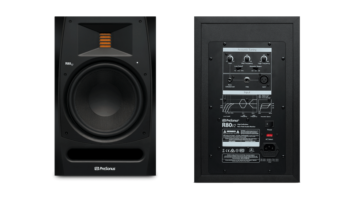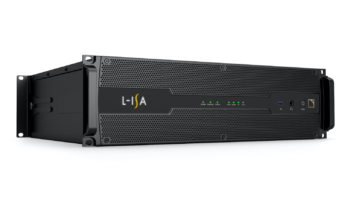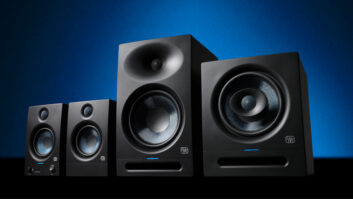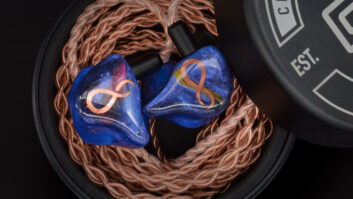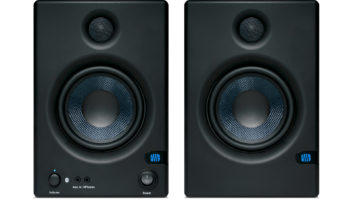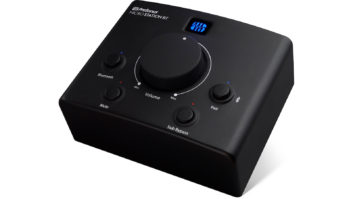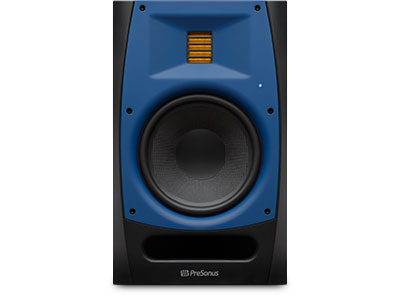
PreSonus recently entered the studio monitor game, debuting with an impressive coaxial two-way called the Sceptre. A newer addition to its monitor line is the R Series, which includes the R80 and R65. Both are two-way monitors featuring AMT ribbon tweeters and Kevlar woofers. Both the R80 and R65 use the Air Motion Transformer patented by Dr. Oskar Heil in 1972. Other companies use this respected ribbon design, including ADAM and EmotivaPro.
The AMT tweeter is paired with a 6.5-inch Kevlar woofer in the case of the R65, and an 8-inch for the R80. The bi-amped design features a Class-D power amp for each driver. The R65 crosses over at 2.7 kHz, and the R80 crosses over at 2.6 kHz. A flat, trapezoidal bass port appears on the front of each model’s cabinet. The cabinet size is on par with other offerings having similarly-sized components.
Amenities
The back panel features a healthy complement of connections and controls. Each model offers balanced XLR and ¼-inch TRS connectivity, with an unbalanced RCA option as well. There is no stereo linking connection, and given the fact that the volume control is on the back panel, the clear intention is to match the level of each speaker and use a monitor controller for overall master volume.
The Acoustic Tuning controls were surprisingly effective at tailoring the sound of the R65s to a room. I spent some time with the monitors in a well-treated studio where they sat on stands in free space. In this case, rolling with a flat setting performed satisfactorily. However, I also spent a lot of time with them in my “Studio B,” which has limited acoustic treatment. Here, the monitors sat on recoil stabilizers, on a desk, inches from a wall. In this case, the tuning controls were certainly welcome.
Each of the three EQ controls—Acoustic Space, HF Driver, and HP Filter—has a single toggle button for switching between four different modes. An LED indicates the mode selected within each of the control choices. The highpass filter is available in a flat setting, or 60 Hz, 80 Hz or 100 Hz. Another is a level control for the tweeter, offering no boost or cut, +1 dB boost, -1 dB cut, or -4 dB cut. And the “acoustic space” control is a low-frequency EQ control. It seems to be a shelf positioned at 250 Hz, which can be bypassed or provide a -1.5dB, -3dB or 6dB cut. This control is specifically designed to counteract the bass buildup that results from placing the monitors too close to a wall.
In Use
From the time I first fired up the R65s, they had a very pleasant sound. Straight out of the box, the bottom end was massive. The midrange was very clear, and the stereo image was broad, deep and very detailed. True to the expectations set by other ribbon tweeters, the top end was crisp and defined while having a very natural, realistic smoothness. When listening to acoustically recorded instruments, there was a real sense that the players were right in front of you.
I started out just trying to get to know the R65s and spent quite a lot of time just listening to music. Given the wide horizontal dispersion of the tweeter elements, I was able to walk around and move far beyond the sweet spot while still experiencing a generous amount of detail in the top end, all while maintaining robust bottom end. I ran them with all of the equalization settings flat for a long time waiting to hear a change as they broke it, but it never happened. They never sounded tight or lacking in bottom end in the first place, so this was by no means a disappointment.
Room Correction
When I eventually started tweaking the equalization controls, I found that the Acoustic Space control made a significant, positive difference. Dropping the bottom end by -1.5 dB helped in balancing out the overall frequency response—the low end was not lost; it was just aligned with the other frequencies. Many other monitors offering equalization for room correction have come up short in this regard. Either they are ineffective in treating the low-end effects of difficult placement, or they compromise the bottom end in doing so. I was pleased with the R65’s ability to flatten itself out.
Listening at a lower level, the -1.5dB drop seemed very effective. At higher volumes, dropping the bass to -3.0 dB seemed to be more appropriate. That said, the fact that those controls were on the back of the cabinets proved to be a bit of a nuisance. I had to tip them forward to access these controls, creating a break in continuity when A/B’ing settings.
Any music seemed to take well to these speakers. When listening to electronically driven tracks, the bass was punchy and solid, and the complexities of the synth-based sound field were fully exposed. Listening to chaotic jazz arrangements, everything stayed clear, without muddying up, and the positioning of players in the room came across perfectly. Classic rock sounded great as the low-midrange warmth of vintage circuits and the enhanced harmonic structure in their top end shone through. I could listen to any music for hours without feeling strained.
Mixing
I used the R65s to mix an alt-country song featuring a lot of layers of different acoustic and textured electric guitars, as well as electric bass, other stringed instruments, and drums and vocals. The monitors laid out a fantastic stereo canvas upon which all of these elements could find a place. EQ adjustments from familiar plug-ins translated well to the monitors to the point that I was confident in the feedback that they provided. Kick and electric bass were the foundations of the bottom end, and when they appeared to be sitting correctly, I double-checked the mix on a tried-and-true pair of headphones. The headphones seemed to confirm that the bottom end according to the R65s was appropriate.
Taking the mix to a high-end pair of monitors for mastering, I was very impressed with the result. There were no significant bumps or holes in the overall frequency spectrum. The center was solid while there was an exciting stereo field playing on the sides. The same mix also sounded great in the worst-case scenario, like phone and laptop speakers. Kick, snare, and vocal all cut perfectly with every lyric intelligible. A nice, balanced amount of guitars and percussion were present, and even a taste of the bass could be heard.

The Results
For the sake of comparison, I shot them out against a pair of KRK Rokit 6 monitors, another mid-level monitor with a 6-inch Kevlar woofer, and then against a pair of ADAM A5s, another ribbon-tweeter monitor.
The R65s had the acoustic space setting at -3 dB and were otherwise flat. The KRKs had the tweeter slightly boosted, and the bass attenuated -2 dB. When listening to EDM, the bass from the R65 was tight. Both the Rokit 6 and the R65 seemed to produce the same level and frequency width of low end, but the Rokit 6 seemed to resonate a little longer. The R65 was a little tighter. In the lower midrange, a drum machine tom that was very prominent on the Rokit 6 seemed to get lost on the R65. Meanwhile, the misty electronic snare seemed fuller-bodied and richer on the R65 and a bit thinner on the Rokit 6.
Listening to hard rock and metal, the Rokit 6s sounded more doctored in the lower midrange. Some muddy frequencies seemed scooped, producing a clearer overall sound. On its own, it sounded quite good. When switching over to the R65, however, this hole became more apparent, making the Rokit sound thinner than the R65.
Comparing the R65 to ADAM A5s I tweaked the EQ on both repeatedly, trying to create as close a comparison as possible, but this ultimately led back to the same -3dB acoustic space setting on the R65, and the A5 running with flat EQ settings. Listening to dense, hard rock, the R65 was a little smoother and more open in the upper midrange. Cymbals and snare on the A5 seemed slightly edgy when compared to the R65. Aside from that, the bottom end was no contest. Granted, the A5 had a smaller woofer, so the R65 bringing more bass was not a surprise, but the cabinet and porting seemed to come into play as well, because the R65’s bass was significantly fuller by comparison.
When switching over to an acoustic folk ballad, the A5 presented a much deeper three-dimensional space than the R65. The buzz of the guitar strings was also more prominent on the A5 while the R65 displayed a much fuller depiction of the body of the instrument. The overall detail and stereo image from both monitor pairs was very pleasant. The R65, once again, seemed very smooth at the top, even during the most biting vocal passages.
The next round was a slow rock song with big room-miked sounds from a jazzy drum kit. There seemed to be a bit of air that was audible on the A5 that didn’t come across as well on the R65. I tried boosting the R65’s tweeter to compensate, but this just led to harshness rather than fixing the problem. Aside from that, the overall sound of the R65 was just bigger and fuller. The stereo image was fantastic, and every component of the mix shone clearly through.
Solid Performer
Once again, PreSonus has delivered a solid and competitive product. The R65 and R80 are both fighting in a crowded space in the marketplace. There are a lot of heavy-hitters living in the $300 to $500 price range with Focal, Genelec, KRK, and even the dual-woofer PreSonus Eris-series battling it out. That said, I was impressed with the R65s from the moment that I flipped them on and that never changed. If I were shopping in this price range, the R65 would be on my short list, especially if placing them in a more challenging acoustical environment.
Product Summary
COMPANY: PreSonus
PRODUCT: R65 Monitor
WEBSITE: www.presonus.com
PRICE: $399.95 (street)
PROS: Great midrange clarity. Full bottom end. Effective room correction.
CONS: Slightly less airy than higher-end ribbon tweeter models.
TRY THIS
When mixing, it is a good idea to listen at an average volume of 78- to 85dB SPL, depending on the size of the space and the proximity of the monitors to your listening position. That said, listening at much lower volumes could reveal issues with the balance of fundamental mix elements. Likewise, blasting the mix may change your perception of the midrange, and reveal the need to make changes. Monitors like the R65s stay very clear with negligible distortion even at high volumes. Make sure to test that when shopping for monitors.
